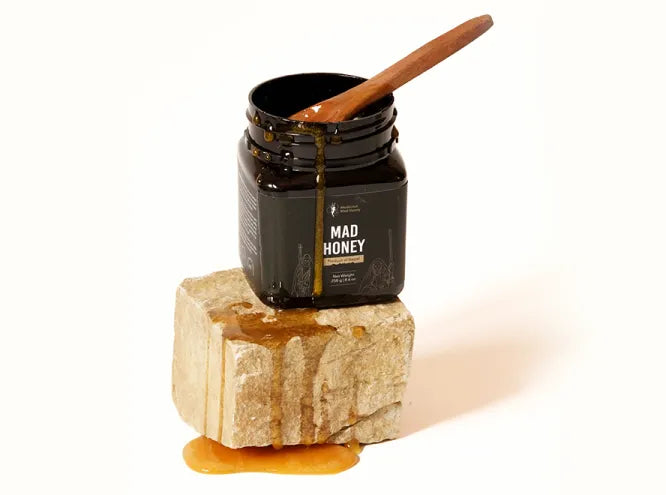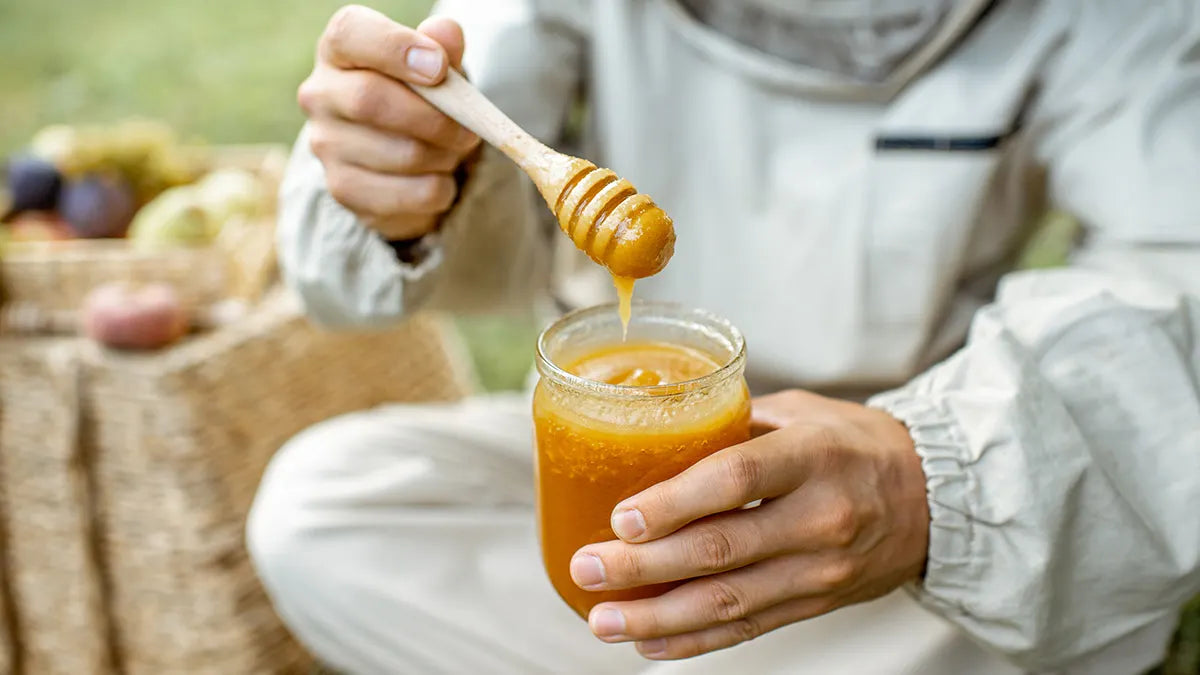The consumption of honey made by the wild Himalayan bees produces hallucinogenic effects. The principal compound found on this honey is Grayanotoxin which is produced in Rhododendron plants, leaves and flowers. The bees collect nectar from these flowers as the availability of these flowers in the Himalayan region are in abundance. The sugary syrup along with the Grayanotoxin is preserved in the honeycombs of these bees which reaches human hands after harvesting.
Although the usage of this honey has been within several traditional and cultural groups around the globe since ancient times, there are some myths regarding the mad honey. It has been deep rooted in traditional medicine for gastrointestinal, anti-inflammatory, anti-microbial and aphrodisiac properties. Although the myths and folklore has created hype and it still is in practice till date modern science has clarified the potential uses and benefits of the mad honey.
Myth #1: Mad Honey is Just Like Any Other Honey
This is totally false as Mad Honey is not like ordinary honey because it contains Grayanotoxins. Ordinary honey is made from normal flowering plants but this specific mad honey is made from rhododendrons and other wildflowers which makes this honey different from rest. The color is deep reddish brown as compared to normal yellow golden elixir. Over consumption of normal honey can lead to increase in sugar levels but overconsumption of this honey can lead to serious hallucinogenic effects, nausea and dizziness. The intoxicating effects are so high that these effects are often correlated to the mad honey poisoning. This intoxicating property is what makes this honey totally unique from the rest of the honey. The standard honey poses no health risk when taken in doses more than recommended while this honey can bring in serious health concerns and needs serious medical attention.

Myth #2: Mad Honey Causes Intense Hallucinations Like LSD or Magic Mushrooms
This is exaggerated by some individuals who used it as a form of recreation. The grayanotoxins found in mad honey may produce slight hallucinations together with altered perceptions but these effects remain significantly weaker than those of LSD and magic mushrooms. Each hallucinatory experience is brief while being mostly mild since users may experience nausea alongside dizziness and these symptoms vary in intensity because of the consumed quantity of product. The hallucinatory effects are better described as disorientation rather than psychedelic one. The effects from this substance do not match the levels of those pharmacological psychedelic drugs.

Myth #3: Mad Honey is Easily Found Everywhere
The easy availability of mad honey is not true. The rare honey product exists mostly in specific regions that include parts of Nepal along with Turkey and some mountainous regions where rhododendron plants thrive there. Harvesters from the local area collect honey which is later used by themselves or sold when harvested in higher quantities. Most consumers cannot buy this product because it remains scarce in common commercial spaces and requires purchase in specific markets specialized in such items.
Myth #4: Mad Honey can Cure Every Disease
No, mad honey can’t cure every disease but can help cure several health alignments. Although mad honey has been employed in folk medicine for several uses, including pain relief and enhancing circulation, it is not a panacea - a cure to all. Its therapeutic advantages are limited and must not be depended fully to cure ailments. It also causes toxic effects if consumed excessively. Always consult a doctor prior to using mad honey for health reasons.

Myth #5: All Mad Honey are the Same
This is incorrect. The potency of mad honey can vary greatly depending on a number of factors including the type of rhododendron flowers the bees are feeding on, from which part of the world it is collected, the species of Rhododendron plants, the local environmental conditions and several other factors. Some mad honey will be more concentrated in grayanotoxins, and therefore stronger, while others may be less concentrated. Therefore, all mad honey is not as potent or the same as it all depends upon the Grayanotoxin constituent.
Myth #6: Mad Honey is 100% Safe for Everyone
This is not true. The therapeutic effects of moderate mad honey consumption benefit certain people but dangerous outcomes occur when anyone takes excessive amounts of it. The natural neurotoxic compound known as grayanotoxins present in mad honey can lead to feelings of Euphoria or dizziness and nausea which all depends on the intake amount. The intake of mad honey can bring in potentially dangerous results for susceptible individuals. Those with existing heart health problems along with individuals taking medications need to refrain from consuming it. Mad honey is not advised to those with pregnancy and children below 18 years of age. Consumers with chronic disease conditions should exercise safety precautions when consuming mad honey because they should take it under the guidance of healthcare professionals.
Myth #7: Mad Honey is Illegal Worldwide
Although the legal status of Mad Honey is still unclarified, it also doesn’t fall under unregulated drug and substance. The regulation of mad honey varies across nations based on its toxicity potential but different regions do not consider it unlawful. Nepal together with Turkey allow the production and sale of mad honey as medical treatment alongside its traditional use in harvest areas. The permissions regarding mad honey usage depend on specific health regulations throughout different regions. The presence of Grayanotoxins and its potential side effects can be a big problem for consumer health. This is the main reason why most countries have neglected it as it falls under the grey zone.
How to Identify Real Mad Honey and Avoid Scams
Always choose mad honey from trusted local sources which promote their product legitimately in the natural production areas including Nepal or Turkey. Small quantities of real mad honey present themselves with reddish or amber coloration that brings out a distinct and slightly bitter taste. Abide by caution with inexpensive or mass-made honey products since these could contain adulterated or counterfeit components. Standard authentic mad honey meets product requirements and provides complete information regarding where it came from and its amount of grayanotoxin content. Buy Mad Honey only from established and reliable vendors who will share information about the origin and manufacturing standards of their product.
Conclusion
The numerous myths about mad honey require validation of legitimate information from medical means. Mad honey differs from ordinary honey because the effects depend on three factors: its origin along with the amount of consumption. Although possessing certain medical advantages the improper use of this substance can be dangerous if taken in doses above recommended guidelines. The availability of mad honey remains limited since its presence is not widespread. Individuals should exercise caution during their attempts to try mad honey by obtaining it from proper sources and understanding the associated potential dangers.





